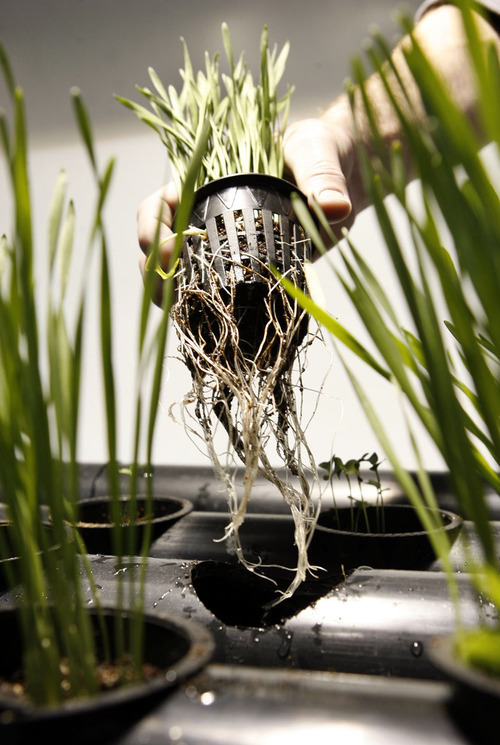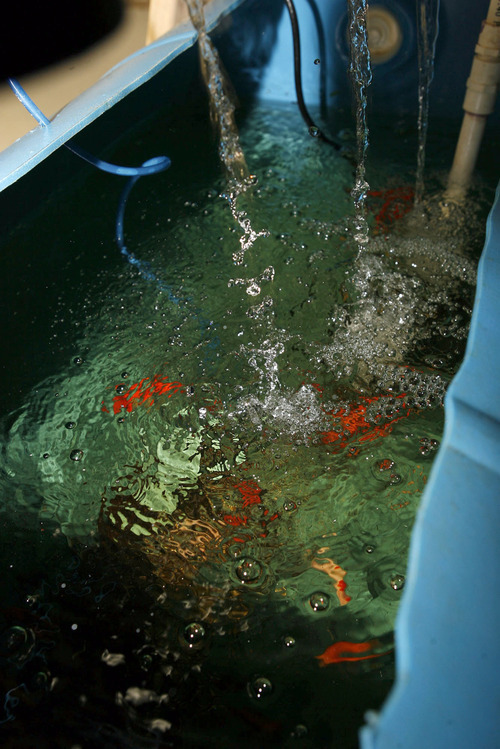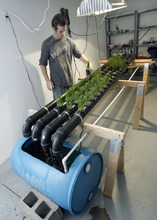This is an archived article that was published on sltrib.com in 2011, and information in the article may be outdated. It is provided only for personal research purposes and may not be reprinted.
The secret ingredient to a successful greenhouse: fish.
Brandan Coleman, founder of the Utah nonprofit Americana, plans to introduce a farming technique to the state's most populous county this year that uses fish — such as koi, tilapia and perch — to more effectively produce crops.
Known as aquaponics, the agricultural innovation combines fish ponds and growing beds in the same greenhouse. The fishes' job: fertilize the plants. The plants' job: clean the water.
"It's a natural ecosystem," Coleman said.
The concept comes amid a rural resurgence in Salt Lake County that has appeared in the form of more community gardens, new laws allowing backyard hens and a first-ever initiative to transform fallow government lands into commercial farms.
It also has appeared in the basement of Coleman's Salt Lake City home. There, lettuce, broccoli and wheat grass have sprouted from a series of pipes that feed into, and out of, a 50-gallon drum swimming with goldfish. Although the system is tiny, Coleman has used it to prove that fish — and the nutrient-rich water they produce by eating and defecating — can be valuable in farming.
"How can we grow more efficiently, more sustainably and more productively?" Coleman asked. "How do we get faster yields? How do get larger yields? I think aquaponics is a solution to all of that."
Coleman's nonprofit is raising money to build its first backyard greenhouse — a project that will cost an estimated $1,000.
Although aquaponics is relatively young in Utah, it has been incorporated into commercial farms elsewhere. Growing Power, a Milwaukee-based instructional farm, has incorporated multiple aquaponics systems into its farms that use tilapia, yellow perch and bluegill. The largest system holds more than 20,000 gallons of water.
Will Allen, who leads Growing Power, described aquaponics as an agricultural technique that is "exploding" in popularity.
And yet only a few systems exist in Utah.
Highland resident Neal Westwood developed his own aquaponics greenhouse using bluegill, rainbow trout and bass. If it weren't for Utah's cold climate, he said, the technique would be a sure sale. But heating the water costs money.
"It is commercially viable and economical — if you are not spending oodles on winter heating," he said. "It works, but is not necessarily economical."
Even so, Julie Peck-Dabling, Salt Lake County's urban-farming coordinator, sees potential in the idea.
"It definitely has a future here," she said. "If they can do it in Milwaukee, they can do it here."
Growing Power's chief insists that it will work in cold communities. Heating a greenhouse with water, Allen said, is cheaper than heating it with air.
Coleman believes it — so much so that he has been peddling the concept door to door in Salt Lake County to raise money for Americana's first greenhouse. Coleman plans to build greenhouses for needy or impoverished families — each one packing a price tag of $1,000. He ultimately would like to erect a larger greenhouse for the public.
Coleman said his nonprofit is really about one thing: abundance.
"What makes America great is innovation and productivity," he said. " We need to get back to that: creating. We need to create abundance. Food is something all of us share in common."
That's where greenhouses come into play.
"The more of these we can build, the more local food production there will be," he said. "That affects all of us by increasing local food productivity and stimulating the economy. Eventually, there is going to be an abundance of food here locally."
But before Coleman can do that he needs to take one big step out of the basement and into people's backyards.
Want to build a greenhouse?
The nonprofit Americana is collecting donations to build "aquaponics" greenhouses for needy families. The cost: $1,000 apiece. Information is available online. • http://www.americanaslc.org









